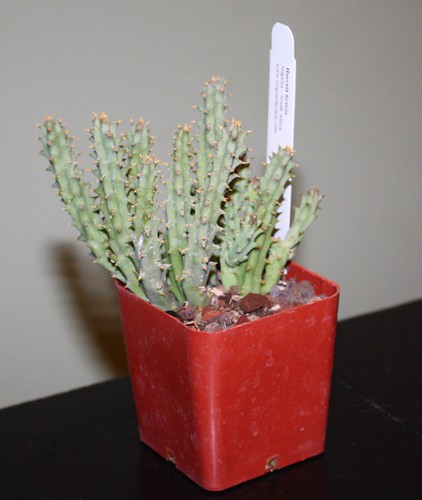Before diving in, I must confess that cacti and succulents are not my passion. There are a couple of groups that interest me, like Stapelia and related genera. I decided to stop by the show and sale of the
Central Oklahoma Cactus and Succulent Society last weekend because I figured it would be interesting to see, take photos and learn more about these plants.
 |
| Rhytidocaulon macrolobum |
I was surprised to see more plants of interest to me than I had expected. The "show" plants were neat, but primarily plants that I enjoy looking at and that I don't have a great desire to grow myself. However, I found many plants on the vendor tables that were of interest to me. The first being the plant pictured above and below. Maybe you think it's ugly, but look at those awesome black flowers!
 |
| Rhytidocaulon macrolobum |
There were quite a few
Pachypodium on display and for sale (sorry, no pictures). I had just been giving a tour at the
Myriad Gardens on Saturday afternoon, where the
Pachypodium are 10 feet tall!
 |
| Euphorbia knuthii |
There were so many
Euphorbia I couldn't count them. As I was telling my tour group,
Euphorbia has to be the most diverse genus I know. If you read my
old post on Euphorbia you would have seen everything from the Poinsettia to the dangerously spiny plants, like the one I purchased this weekend.
 |
| Euphorbia cylindrifolia |
The
Euphorbia pictured below has a growth habit more like
Mamillaria (those spherical cacti with spines all over them).
 |
| Euphorbia valida |
 |
| Dyckia marneir-lapostellei |
Check out the ghostly colors of the
Dyckia and
Crassula.
 |
| Crassula deceptor |
The little
Avonia was quite adorable. It looks like a miniature and really doesn't look real.
 |
| Avonia quinaria v. alstonii |
You have probably already seen my
cucumber orchid. Now I see there is a cucumber succulent!
 |
| Senecio pendula |
Sansevieria has quite a dedicated following. This show had two plants, one being the famous
Sansevieria masoniana, with big floppy leaves. The other was more to my liking,
Sansevieria scabrifolia.
 |
| Sansevieria masoniana 'Mason's Congo' and Sansevieria scabrifolia |
Most of the plants I am showing won an award, but the cactus below won "Best Cactus." Check out that long fur hanging off of the pads.
 |
| Opuntia tequiliana - look at that fur! |
The only
Stapelia-like plant in the show was this
Huernia. It was a really big plant that is supposedly just 3 years old. It must be a vigorous grower.
 |
| Huernia thuratii |
I ended up purchasing 4 plants, 1 of which was an orchid. I had been told by some friends that
Eulophia petersii is easier to find at succulent shows than at orchid shows, since it likes to grow so dry. I was talking with a vendor at this show and he was telling me about how he once heard someone describing this plant as having "orchid-like flowers"...
 |
Huernia hystrix
|
Two of the plants that I purchased are from my Stapeliae:
Huernia hystrix and
Stapelia hirsuta. The
S. hirsuta is the one that gets
really hairy flowers. It is also probably the species that is most similar to my
Stapelia gigantea, which grows really well for me. So I feel confident I can get it to bloom eventually.
 |
| Stapelia hirsuta |
The last plant I purchased is the
Euphorbia, which I mentioned earlier in this post. Dangerously spiney!
 |
| Euphorbia aeruginosa |
I don't plan to become a cacti and succulent addict, but I would like to go to this show again in the future. There were definitely some neat plants.




















